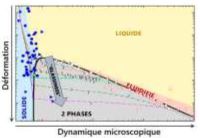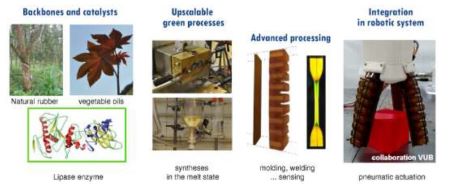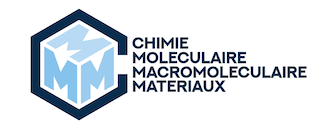Chimie et Physicochimie de la Formulation (CPF) team
The team develops original syntheses and implementation processes to invent functional materials targeting a variety of application fields. The rational formulation of materials requires an understanding of the relationship between small-scale properties (microstructure, reactivity, kinetics) and macroscopic properties (electrical, optical, rheological, structural). Experimental innovation and multi-scale modeling are key elements of this approach.
Theme 1. Colloidal dispersions and functional polymers: formulation, dynamics, flow
The development of eco-compatible rheological additives requires new water-soluble macromolecules with controlled architecture and composite formulations. With our industrial partner Coatex, we have designed a "toolbox" for designing structurally adjustable polymers and exploring their applications: associative and structured microgels, functional polyelectrolytes. We are particularly interested in microgels as archetypes of a large class of colloidal glasses made up of deformable particles: emulsions, star polymers, grafted nanoparticles (ACS Nano 2021, 15, 16697).
The outstanding results obtained relate to interlocking applications:
– Development and modeling of a "green" encapsulation technique using associative amphiphilic polymers (Langmuir 2017, 33, 14020).
– Rational formulation of hypoallergenic threshold fluids for cosmetics (J. Phys.: Condens. Matter 2021, 33, 404003).
And in parallel, fundamental understanding of the rheology of these systems, using experiments, simulations and statistical physics theories:
– Memory effects in dense suspensions. We have shown that they result from trapped stresses associated with the persistence of the anisotropic polarization of the pair distribution function after flow. We now know how to "write", "read" or even "erase" controlled stress distributions (J. Rheol. 2022, 66, 717).
– Relationship between microscopic dynamics, characterized by non-affine deformations and spatio-temporal heterogeneities, and macroscopic constitutive equations (J. Rheol. 2022, 66, 717).

– Microscopic origin of the flow threshold that separates a stopped state, seat of very slow dynamics dominated by the relaxation of trapped stresses, and a fluidized state, of diffusive dynamics activated by shear. Guided by this understanding, we have proposed a unified description of the flow setting of hindered suspensions (Nat. Phys 2023, in press).
Collaborations : University of Texas at Austin (Pr Bonnecaze, Dr Khabaz); FORTH and University of Crete (Pr Vlassopoulos); University of Montpellier (L. Cipelletti, L. Ramos).
Partnerships: Coatex (1 CIFRE); ITN Colldense (1.5 thesis); ITN Dodynet (1 thesis), ITN Yieldgap (1 thesis), DIM Respore.
Theme 2. Soft matter for medicine
Soft matter offers great potential for biomedical innovation. Working with clinicians and biologists, we are designing high-performance materials with novel functionalities, and exploring the physical transformations they undergo under conditions of medical interest. We are studying the biomimetic mechanical behavior of anisotropic hydrogels for ligament reconstruction, the gelation of thermosensitive macroporous hydrogels for encapsulation and cell delivery, and adhesion between hydrogels and internal organs.
Our work on tissue adhesion is a good illustration of this approach. Using an original ex vivo peeling protocol on animal liver, we show that fluid exchange determines adhesion between hydrogel and tissue. By modeling the competition between wetting and drainage at the interface, we are able to capture the transition from a lubricated to an adhesive regime. In vivo experiments on animal models have demonstrated that this phenomenon explains the loss of adhesion observed on continuously hydrated living tissue (PNAS 2019, 116, 738).
This work is being used to explore strategies for enhancing adhesion using super-absorbent membranes or coatings of pro-coagulant silica particles that create adhesion in the presence of blood (Appl. Bio Mater. 2020, 3, 8808). We are now investigating the prospects offered by these concepts for the design of surgical adhesives, hemostats and local drug delivery devices.

Collaborations: Ecole Nationale Vétérinaire de Maisons Alfort (Pr Viateau ; Pr Manassero); Institut de Biomécanique Humaine - ENSAM (Pr Pillet ; Pr Rohan); Centre Hépato-Biliaire de l’Hôpital Paul Brousse (Pr Vibert ; Pr Golse); Mines Paris. Postech University (Pr Yi); Paris-Cergy University (Pr. Pauthe).
Partnerships: ANR NanoBioTape (1 thesis), Carnot Mines (1 thesis), DIM Respore (1 thesis).
Theme 3. Soft matter for robotics
Soft robots, capable of deforming to perform a complex task, are proving promising for biomedical, food or space applications, as the mechanical impedance of grippers is better matched to that of the objects being manipulated. However, this characteristic also means greater vulnerability. As part of the FET SHERO project, we are developing self-healing elastomers for this application. Building on our pioneering experience in self-repairing materials, our efforts in this project have been aimed at solving three problems: i) the addition of a detection capability, ii) the speed of action and iii) the activation of chemical reactions at T<100°C.
We have developed an original solution based on natural rubber, which offers an elastic response with virtually zero dissipation at room temperature. This bio-sourced material ensures good energy efficiency and rapid cycling. The result is efficient, self-healing piezoresistive sensors and pneumatic actuators. To reduce energy demand and preserve electronics, the team has been working on enzymatic catalysis of the chemical reactions involved in implementation and self-repair, with the bio-sourced solution again providing unique performance here (ACS Macro Letters 2023, 12, 338, Advanced Materials 2022, 34, 2104798), Biomacromolecules 2021, 22, 4544).

Collaborations: Vrije Universiteit Brussel, EMPA Zürich, University of Manchester, Monash University
Partnerships: FET OPEN SHERO (Self-Healing Soft Robotics).
Topic 4. Performance and limitations of vitrimeric materials
The conversion of conventional thermoplastic or thermoset polymers into vitrimers offers the promise of new combinations of properties and performance. To achieve this, the vitrimers must retain the processing capability and essential properties of the starting polymers.
To this end, we are developing a methodology that combines: i) chemical analysis: in operando monitoring, final product identity, model reactions; ii) rheological analysis at all stages of processing, including latency and gel point control for reactive blends; iii) structural analysis, revealing phase transitions and separation; iv) performance analysis in relation to chemical, rheological and structural properties.
The main results are as follows:
a) polyethylene undergoes multiscale phase separation governed by miscibility between polymer and modifier (Macromolecules 2019, 52, 432), which affects rheological properties (Macromolecules 2020, 53, 1852).
b) stress localization is suppressed in polybutylene terephthalate, improving thermomechanical strength below the melting point (Macromolecules 1838, 54, 1838).
c) theoretical modeling of the viscoelastic behavior of vitrimer networks (Macromolecules 2022, 55, 7605).
d) Demonstration of the role of hydroxide functions in epoxy vitrimer chemistry and how to control them to increase the glass transition temperature while limiting spurious reactions (Macromolecules 2022, 55, 6982).

Collaborations: ESPCI Gulliver (Pr L. Leibler); Université de Lorraine; University of Akron (Pr Khabaz).
Partnerships: ANR MATVIT (1 thesis) ITN Vitrimat (1 thesis).

